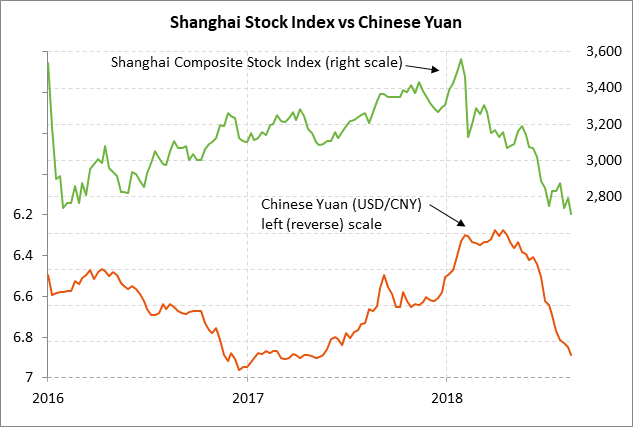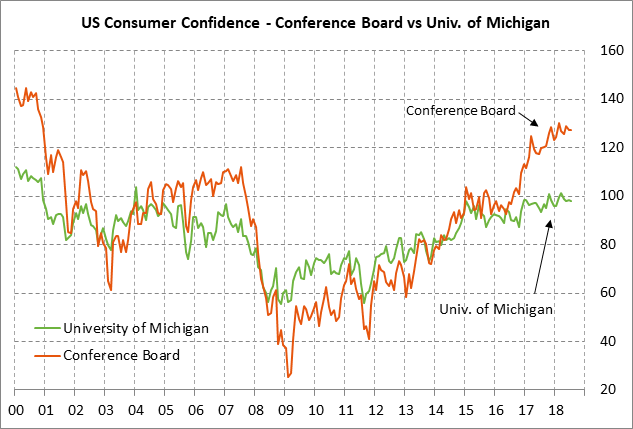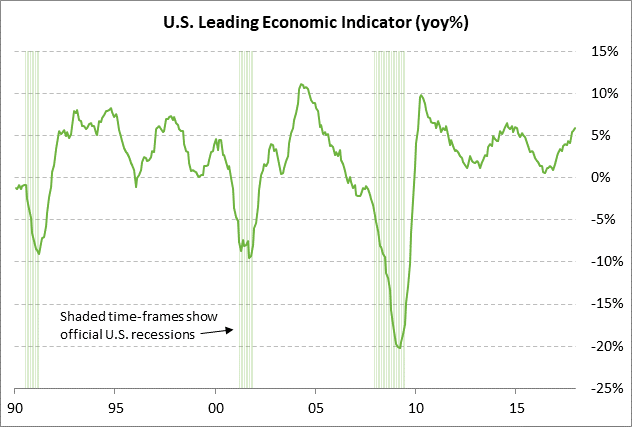- Hopes emerge for US/Chinese trade negotiations
- US/Turkish confrontation continues as Mnuchin threatens more sanctions
- U.S. consumer sentiment expected to remain strong
- U.S. LEI expected to show another strong increase
Hopes emerge for US/Chinese trade negotiations — China’s Vice Commerce Minister Wang Shouwen will lead a delegation of Chinese officials to meet in late August with David Malpass, undersecretary for international affairs at the Treasury. Wang Shouwen is responsible for China’s worldwide trade negotiations.
News of the talks provided some support for the global stock markets on Thursday. Nevertheless, China’s Shanghai Composite index on Thursday fell to a new 2-1/2 year low and corrected lower by -25.5% from May’s 2-3/4 year high, which means Chinese stocks are in bear market territory.
This week’s emerging market turmoil and weaker-than-expected Chinese economic data may have prompted the Chinese government to take another stab at negotiations. Top Chinese officials in May thought they had the outline of a trade deal with the U.S. but President Trump within a few days disavowed the deal. Since then, China has been reluctant to re-engage with the Trump administration and the two sides have simply been escalating their tariff threats.
The new exploratory talks won’t come in time to prevent the implementation next Thursday (Aug 23) of U.S. and Chinese tariffs on $16 billion worth of each other goods. However, the late-August talks could lead to at least a delay in the Trump administration’s intent to implement a 25% tariff on $200 billion of Chinese goods after the public comment period ends on September 5. China has already announced that it would retaliate to those U.S. tariffs with tariffs ranging from 5% to 25% on $60 billion of U.S. goods.
If the September tariff round goes into effect, then the U.S. would have a penalty tariff on $250 billion worth of Chinese goods, accounting for nearly half of U.S imports from China totaling $525 billion over the last 12 months. Meanwhile, China would have a penalty tariff on a total of $110 billion of U.S. products, representing about 80% of Chinese imports totaling $135 billion over the last 12 months.
There is possibly some hope for a cease-fire before the Trump administration drops the big hammer with a 25% tariff on $200 billion of Chinese goods. There could be a model for a cease-fire along the lines of the recent US/EU deal. European Commission President Juncker was able to talk President Trump into a tariff cease fire and the beginning of serious trade talks with only minor concessions such as a promise to buy more U.S. LNG and soybeans. However, the US plans to drive a much harder bargain with China and wants to see much bigger up-front concessions. Indeed, the U.S. is seeking a major revamp of China’s economic model with (1) no subsidies for the high-tech industries that China plans to promote with its “Made in China 2025” plan, (2) much greater IP protections for U.S. companies, (3) a sharp increase in Chinese purchases of U.S. goods to reduce the US/Chinese trade deficit, and (4) a host of other demands.
US/Turkish confrontation continues as Mnuchin threatens more sanctions — Treasury Secretary Mnuchin on Thursday said that the Treasury will slap sanctions on more Turkish government officials if Turkey does not quickly release American pastor Andrew Brunson.
The U.S. has already slapped sanctions on Turkey’s Justice and Interior ministers and has doubled tariffs on Turkey’s steel and aluminum. Turkish President Erdogan this week responded by slapping retaliatory tariffs on up to $1.8 billion of U.S. goods and calling for a public boycott of U.S. electronics such as iPhones.
The Turkish lira on Thursday extended its 3-session recovery rally and closed +1.90%. Despite the 3-day rebound, the lira is still down 54% year-to-date. Meanwhile, the iShares Turkish stock ETF (TUR) on Thursday closed -2.76% and is down -24% month-to-date.
The lira has recovered somewhat this week after (1) the Turkish government made it much more expensive to short the lira, (2) the Turkish central bank tightened bank liquidity to push short-term rates slightly higher, and (3) Qatar agreed to invest $15 billion in Turkey. However, President Erdogan refuses to allow the Turkish central bank to implement the big interest rate hike that is the only real solution for the weak lira. As long as the government refuses to raise interest rates, the lira remains subject to a renewed plunge since Turkish fundamentals remain grim, with high inflation, a huge current account deficit, high external debt, and low foreign currency reserves.
U.S. consumer sentiment expected to remain strong — The market consensus is for today’s preliminary-August University of Michigan U.S. consumer sentiment index to show a small +0.1 point gain to 98.0 following July’s small -0.3 point decline to 97.9. The index is moving sideways just mildly below March’s 14-year high of 101.4. U.S. consumer sentiment is seeing support from (1) the strong economy and labor market, (2) rising wages and income, and (3) rising household wealth due to strong housing prices and stock prices. Negative factors include (1) Washington political uncertainty, (2) tariffs, and (3) high gasoline prices.
U.S. LEI expected to show another strong increase — The market consensus is for today’s July U.S. leading indicators index to show another solid increase of +0.4%, adding to June’s +0.5% increase. The LEI remains in very strong shape at +5.8% y/y, which is positive for the U.S. economic outlook. U.S. GDP soared by +4.1% in Q2 and is expected to remain strong at higher than 3% in the second half of 2018 before tailing off in 2019 and 2020 as the tax effects fade.



